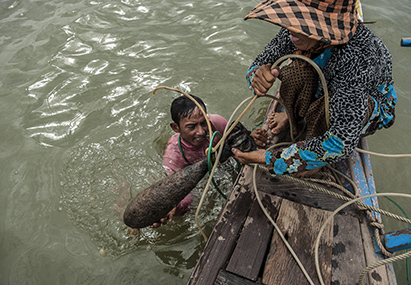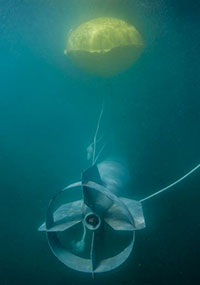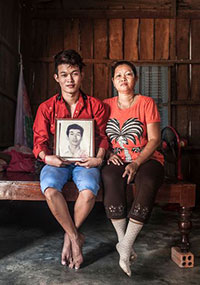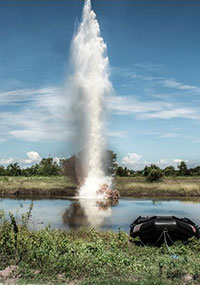Dark Water: Cambodia's UXO Divers
 |
By photographer
|
Kerry Packer Civic Gallery Exhibition
Gallery open Monday - Friday 9am - 5pm (Thursdays until 7pm)
Hawke Building level 3, UniSA City West campus, 55 North Terrace, Adelaide
"Dark Water" documents the formation of Cambodia's UXO Salvage Diver Unit tasked with clearing the rivers and lakes of The Kingdom of UXO left from years of conflict and Civil War.
 It's been more than 35 years since the Khmer Rouge regime collapsed. During its brief rule of Cambodia - less than four years - an estimated two million people died; hundreds of thousands were also killed during the civil war that preceded and followed Pol Pot's brutal 1975-79 regime.
It's been more than 35 years since the Khmer Rouge regime collapsed. During its brief rule of Cambodia - less than four years - an estimated two million people died; hundreds of thousands were also killed during the civil war that preceded and followed Pol Pot's brutal 1975-79 regime.
Cambodia continues to pay the price of these decades of conflict including with the deadly hidden threat of landmines, which kill and injure dozens of people each year. Since the early 1990s, the government's Cambodian Mine Action Centre (CMAC) has trained deminers and cleared landmines from large swathes of the country.
CMAC's responsibilities took a significant new direction two years ago when the organization, working in conjunction with U.S. non-profit the Golden West Humanitarian Foundation, decided to establish Cambodia's first elite salvage diving unit. Their job - to tackle the underwater menace from those years of conflict, the unknown number of bombs and unexploded ordnance (UXO) that litter in Cambodia's waterways and rivers.
Two years of gruelling training saw the initial group of 40 volunteers whittled down to just nine - and in mid-May the team successfully completed its first mission: recovering and making safe a 500-pound U.S.-made Mark-82 bomb that was dropped during the U.S. bombing of Cambodia, and that ended up nose-down in the Mekong River near the capital Phnom Penh.
 The nine divers have been trained not only to dive and recover explosives, but - given the near-zero visibility that is common in the silt-heavy waters of the Mekong - had to learn to do so blind in depths of up to 30 meters and against strong currents. These are hostile conditions and require extraordinary dexterity, as well as physical and mental strength.
The nine divers have been trained not only to dive and recover explosives, but - given the near-zero visibility that is common in the silt-heavy waters of the Mekong - had to learn to do so blind in depths of up to 30 meters and against strong currents. These are hostile conditions and require extraordinary dexterity, as well as physical and mental strength.
The unit's next task is to survey an ammunition barge that was sunk during the early 1970s, one of many that carried supplies along the Mekong River in a vain attempt to support the pro-U.S. Khmer Republic administration that was fighting the communist Khmer Rouge.
After that, the team will remove any UXO that is on the barge and make it safe, taking the explosives from what it recovers and processing those into smaller charges that demining teams use to blow up landmines and other explosive remnants of war found in the field. After all, it's not only bombs that continue to endanger the population: the country still has to contend with other unexploded fragments of war including hand grenades, mortar rounds and bullets.
But it's the rivers and waterways that this project has focused on. Fishermen regularly catch their nets on the boats and large ordinance, and most - unable to afford the loss of a net - dive beneath the water (on a compression pump attached to a plastic tube) to cut free their nets. They also face the danger of pulling up small explosives in their nets. Dredgers that work the rivers collecting sand to be sold for construction regularly pull small-scale ordnance from the rivers and, rather than reporting them for fear of holding up their work, simply throw them back into the river or sell them for scrap.

In the space of just two years, CMAC's dive team has become one of the leading such groups in the world, and is the first such dive team with a humanitarian focus to have been built from scratch. Although they are well aware of the dangers they face, the team members make little of their bravery. Doing this job, they say, is simply their duty as they seek to build a better future for Cambodia.
Charles Fox is a British born photographer currently based in Cambodia and has been working in Asia since 2005. He has a degree in Photojournalism from the London College of Communications and is part of Getty Global Assignments.
Charles is also the creator of FOUNDCambodia a web based Not-for-profit archive of Cambodian family portraits. The project looks before and after the Khmer Rouge. The projects aim to create a visual history of Cambodian Society through photography, documenting what was lost and how society rebuilt itself.
His work has been widely published including The Sunday Times Magazine, The Wall Street Journal , The Washington Post and National Geographic and he has featured in several interviews on the BBC World Service and the Wall Street Journal’s – Asia Today programme.
|
|
While the views presented by speakers within the Hawke Centre public program are their own and are not necessarily those of either the University of South Australia or The Hawke Centre, they are presented in the interest of open debate and discussion in the community and reflect our themes of: strengthening our democracy - valuing our diversity - and building our future.
The copying and reproduction of any transcripts within the Hawke Centre public program is strictly forbidden without prior arrangements.




